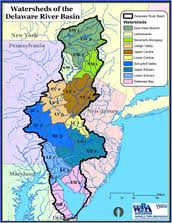The Delaware River Basin Commission published rules Tuesday for Marcellus Shale hydraulic fracturing, or fracking, and has scheduled a vote to adopt at its November 21st meeting in Trenton. The governors of the four basin states — New Jersey, Pennsylvania, Delaware and New York — have votes. The five-member panel also includes a federal representative, the commander of the Army Corps of Engineers, North Atlantic Division.
Under the proposed rules, a maximum of 300 natural gas wells could be drilled over an 18-month trial period, ending an existing moratorium within the region. Maya van Rossum of the Delaware Riverkeeper and the heads of four other environmental groups said in a joint statement: “As experts and attorneys comb through the modified rules, some particularly egregious provisions in the proposed regulations stand out.” The groups will fight “to prevent pollution from gas drilling in the Delaware River watershed.”
According to Kathryn Klaber, the president of the energy industry’s Marcellus Shale Coalition, drilling and fracking will bring many needed jobs to the area. “We’re certainly encouraged that this important process continues to move forward toward the goal of responsibly producing more clean-burning American natural gas,’’ Klaber said.
“By issuing these modified draft regulations, the federal government continues to ignore New Yorkers’ concerns about the impact fracking may have on our environment, health and homes,” said New York Attorney General Eric T. Schneiderman, who has filed a federal lawsuit meant to halt drilling in the basin at least until a cumulative adverse impact study is performed, according to the Wall Street Journal.
Also, a rally and protest demonstration has been called for Trenton, NJ, ahead of the vote by the DRBC to express the concerns about the diverse impacts of horizontal drilling and fracking in a watershed that serves 15 million people.

